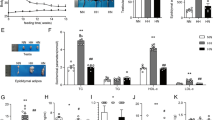Abstract
OBJECTIVE: To determine if chronic administration of a low level of dehydroepiandrosterone-sulfate (DHEAS) (10 µg/ml drinking water) attenuates adiposity in male Osborne-Mendel rats fed low-fat (11% of kcals) vs high fat (46% of kcals) diets. DESIGN: Rats were randomly assigned to one of four treatment groups for 6 wk in this 2×2 factorial study. The main effects tested were diet (low vs high fat) and DHEAS (− or +). SUBJECTS: Male Osborne-Mendel rats (initial body wt approximately 265 g) MEASUREMENTS: Adipocyte mass, size and number from two major fat depots (retroperitoneal, epididymal); mass of one subcutaneous adipose depot (inguinal); serum levels of triglycerides, insulin, glucose and DHEAS; brown adipose tissue (BAT) mass; body weight gain, food and water consumption, and residual carcass composition. RESULTS: DHEAS treatment had no effect on weight gain, food consumption or water intake. DHEAS-treated rats fed the high-fat diet had smaller fat pads containing fewer adipocytes and less carcass lipid than the non DHEAS-treated rats fed the high-fat diet. In contrast, DHEAS-treated rats fed the low-fat diet had similar levels of adipose tissue mass and cellularity compared to control animals fed the low-fat diet. CONCLUSION: Administration of a low dose of DHEAS (10 µg/ml or 0.8 mg/kg body wt/d) in the drinking water of young male Osborne-Mendel rats fed a high-fat diet for 6 wk reduced carcass lipid, fat depot mass and retroperitoneal and epididymal adipocyte number compared to their high-fat-fed cohorts. In this study, the antiobesity effects of DHEAS were specific to the level of dietary fat used.
This is a preview of subscription content, access via your institution
Access options
Subscribe to this journal
Receive 12 print issues and online access
$259.00 per year
only $21.58 per issue
Buy this article
- Purchase on Springer Link
- Instant access to full article PDF
Prices may be subject to local taxes which are calculated during checkout
Similar content being viewed by others
Author information
Authors and Affiliations
Rights and permissions
About this article
Cite this article
Lea-Currie, Y., Wen, P. & McIntosh, M. Dehydroepiandrosterone-sulfate (DHEAS) reduces adipocyte hyperplasia associated with feeding rats a high-fat diet. Int J Obes 21, 1058–1064 (1997). https://doi.org/10.1038/sj.ijo.0800516
Received:
Revised:
Accepted:
Issue Date:
DOI: https://doi.org/10.1038/sj.ijo.0800516
Keywords
This article is cited by
-
The effect of androgens on ovarian follicle maturation: Dihydrotestosterone suppress FSH-stimulated granulosa cell proliferation by upregulating PPARγ-dependent PTEN expression.
Scientific Reports (2015)
-
Dehydroepiandrosterone-Sulfate Modifies Human Fatty Acid Composition of Different Adipose Tissue Depots
Obesity Surgery (2011)
-
Dehydroepiandrosterone and human adipose tissue
Journal of Endocrinological Investigation (2006)
-
Transformations of DHEA and its metabolites by rat liver
Lipids (2002)
-
Dehydroepiandrosterone alters phospholipid profiles in Zucker rat muscle tissue
Lipids (2001)



